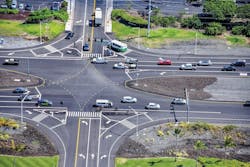By: Brian W. Budzynski
Sometimes it’s a matter of months; sometimes it’s a decade or more. In the case of the Queen Kaahumanu Highway Widening project, it was just about a decade right on the nose.
Bids for this project opened in July 2008. From the start, this project faced many obstacles, including several bid protests and a protracted Section 106 consultation process.
In July 2010, the Hawaii DOT (HDOT) was able to give Goodfellow Bros. Inc. notice to proceed with the design, with a goal of opening construction in early 2011.
However, construction did not start as anticipated. The discovery of previously unknown historic sites, including burials and human remains, required reopening the Section 106 consultation process and evaluation of Section 4(f) avoidance and mitigation. The Section 106 review process is an integral component of the National Historic Preservation Act (NHPA) of 1966. Section 106 requires each federal agency to identify and assess the effects their actions will have on historic resources. The goal of Section 106 is to seek agreement among stakeholders regarding preservation matters arising during the review process.
Section 4(f) of the U.S. DOT Act of 1966 prohibits the Federal Transit Administration (FTA) and other U.S. DOT agencies from using land from publicly owned parks, recreation areas (including recreational trails), wildlife and water fowl refuges, or public and private historic properties, unless there is no feasible and prudent alternative to that use and the action includes all possible planning to minimize harm to the property resulting from such use. The protracted Section 106 and 4(f) process and consultations were time-consuming, as the interests of many different agencies and advocacy groups, including Native Hawaiian organizations and the National Park Service, needed to be considered to agree on a path forward. It delayed the start of construction until September 2015.
Then, during construction, there were two major issues related to the Section 106 evaluation that cropped up, resulting in the overall completion date to slip a further five months, as outlined by Hawaii Asphalt Paving’s Jon Young in his article on this project in our February issue: “The first delay resulted from the need to redesign the project’s southern segment. The National Park Service and several Native Hawaiian organizations expressed concerns about archaeological sites in the Kaloko-Honokohau National Park during the Section 106 consultations. As a result, HDOT had to shift a portion of the highway to reduce its footprint. The redesign was not complete by the time the mass excavation work was nearly finished, which resulted in a one-month project slowdown between May and June 2016. A further delay occurred in July 2016, when HDOT identified several breaches of two trails that were listed on the State Inventory of Historic Places. HDOT also discovered the area of potential effect did not include connections to the adjoining roads. Construction of the project continued, slowly, until September 2016, when work was stopped. The combination of aforementioned issues, along with finalizing the design of said connections, delayed construction ... until Jan. 30, 2017.”
Yet, despite these seemingly insurmountable concurrent obstacles, the $128 million project got fully underway. The highway from Kealakehe Parkway to Keahole Airport Road grew from two lanes to four lanes. Additionally, six new signalized intersections, drainage systems, utility relocations, safety features such as guardrails and medians, and landscaping befitting the location of the highway, as well as 4.5 miles of new water lines, were installed. The project also included a new sewer system to move wastewater from regional developments to the Kealakehe Wastewater Treatment Plant and an R-1 line to bring back treated water.
Paving operations resulted in the placement of just over 117,700 tons of hot-mix asphalt, with mix designs breaking down as: State 4 (1.5 and 2 in. thickness) at 38,310 tons; ATB (3 and 6 in. thickness) at 79,410 tons; and State 5 (leveling) at 10 tons. Morevoer, approximately 79,400 tons of asphalt-treated base course was placed in 3-in. and 6-in. lifts. The State Mix 4, which is similar to Superpave 12.5 mm, served as the surface course.
Paving contractor Grace Pacific incorporated 20% RAP into its mix designs for most of the work. The company’s plant is located in the vicinity of the project, which negated what might have been the challenge of getting material to the worksite. Prior to paving, just over 46,600 tons of the existing road was removed by cold planing at thicknesses ranging from 1.5 to 10 in. across the length of the site.
The asphalt mixes were delivered to the project by a combination of super-, semi-, and tandem-end dump trucks. All material was dumped into a Roadtec SB-2500 shuttle buggy, then unloaded into a Roadtec RP-195 rubber track paver with Carlson Easy Screed EZ IV. The number of trucks varied, but was averaged seven to 12 each day, depending on the day’s production, haul cycle to work area location, whether crews were paving amidst or without traffic, and whether it was a day or night shift.
To assure consistent pavement quality, Grace Pacific employed a grade-control system ordinarily used on the earthwork, utilities, and grading portions of a construction project, but not typically used in paving operations. The 3-D grade-control system was used on some of the milling and paving portions of work on the existing highway, resulting in a smooth riding pavement. The 3-D machine-control systems put the design surfaces, grades, and alignments inside the cab, giving operators control over cold planing and paving. Using CAD, SSFM worked with Grace Pacific to develop the 3-D milling design used for the resurfacing portion of the project.
At long-last, August 9, 2018, saw a community-wide celebration for the revamped and revitalized Queen K. As the poet wrote, “All’s well that ends well.”
About The Author: Budzynski is senior managing editor of Roads & Bridges.
